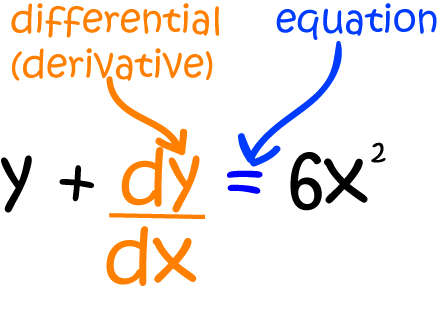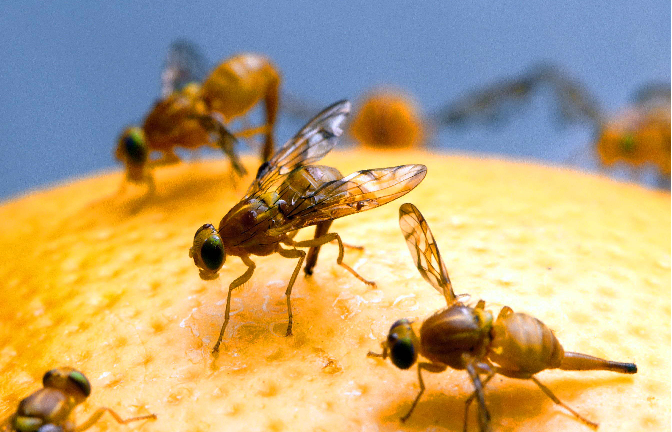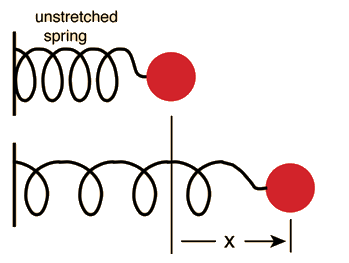Calculus
Chapters
Differential Equations
Differential Equations
Introduction
Differential Equations are equations involving a function and one or more of its derivatives.
For example, the differential equation below involves the function \(y\) and its first derivative \(\dfrac{dy}{dx}\).

Solving Differential Equations
Solving differential functions involves finding a single function, or a collection of functions that satisfy the equation.
Not all differential equations can be solved, but there are a number of tricks that can be used to solve equations of certain types.
Let's have a look at some of the different types of differential equations that we can solve. Later articles will show you how to solve separable, some homogeneous and some linear differential equations.
Why does anyone care about differential equations?
Differential equations have many uses in fields such as biology, finance and engineering. We often encounter differential equations when we are trying to descirbe how different things in our world change.
Example (Fruit flies)
 You've probably encountered fruit flies before. They're the pesky little things that seem to materialise out of thin
air and buzz around the stoned fruit in the summer. Biologists are interested in fruit flies because they breed quickly and easily,
and are useful for exploring the transmission of genetic traits.
You've probably encountered fruit flies before. They're the pesky little things that seem to materialise out of thin
air and buzz around the stoned fruit in the summer. Biologists are interested in fruit flies because they breed quickly and easily,
and are useful for exploring the transmission of genetic traits.
Biologists are also interested in modelling the growth of populations, and fruit fly populations certainly grow! You need fruit flies to produce more fruit flies, and as you get more fruit flies, the fruit fly population increases more and more rapidly. So, if I want to model the growth of the fruit fly population in and around my fruit bowl, I need to come up with some parameters (variables) for my model. I think the following will be helpful:
- The time, \(t\).
- The number of fruit flies present and any time \(t\). Let's call it \(F\).
- The rate of change of the fruit fly population, \(\dfrac{dF}{dt}\).
- The initial population \(F\) is \(1,000\)
- The growth rate \(k\) is 15 new fruit flies per day for every current fruit fly.
But that only gives me the population at a specific time. My fruit fly population is constantly, annoyingly, increasing, and I want to model its growth at any time. The better option is to set up a differential equation. We say that the rate of change (at any time) of the fruit fly population is equal to the population's growth rate times the number of fruit flies present at that time:
differential equation because it provides a relationship between a function \(F(t)\) and its derivative
\(\dfrac{dF}{dt}\). This particular differential equation expresses the idea that, at any instant in time, the rate of change of the population of fruit flies
in and around my fruit bowl is equal to the growth rate times the current population.
Differential equations can be used to model many different things including population growth and decline, radioactive decay, the motion of springs and other bodies, the orbits of spacecraft, the motion of waves, and solar flares. Because they describe rates of change, differential equations are a natural choice of tool to describe many different objects in our universe.
Using Differential Equations
Although they provide a powerful technique for expressing rates of change, differential equations are difficult to use unless we develop methods for finding their solutions. Techniques for solving differential equations often involve applying tricks to reduce the differential equation into a simpler format that no longer involves the derivatives. We can then use the solutions to do calculations, make predictions, draw graphs, and so on. Let's have a look at a few more real-world uses of differential equations.
Compound Interest
When compound interest is applied, the invested (or borrowed) money acts a bit like our fruit flies. You need to invest money to get money, and the more
money you have, the more money you end up with. In compound interest, the initial amount of money invested earns interest, but so does the interest
on the investment. This interest is calculated after a given time period such as a month, a quarter or a day and added to the original amount.
You may have seen formulae for compound interest in the sequences and series section of your maths textbook. These are the sorts of formulae you get when the interest is added to the original investment monthly or yearly, but when it is continuously calculated and compounded, you need a differential equation to model the equation.
It's time to come up with some parameters for the compound interest model. We need:
- The amount invested, \(P\).
- The interest rate, \(r\).
- The time, \(t\), and
- The rate of change of the amount invested, \(\dfrac{dP}{dt}\)
Solving this equation
Coming up with this differential equation is all well and good, but it's not very useful unless we can solve it. Luckily, this is
one of the types of differential equations that can be solved easily. It's an example of a separable differential equation,
and we'll talk more about them in another article.
For now, you just need to know that this equation has the following solution:
Let's have a look at the value of an investment of \(\$2,000\) at an interest rate of \(5\%\), continuously compounded over 3 years:
Further examples of differential equations
The Verhulst Equation and the Carrying Capacity of Environments
Back to Our Fruit Flies
 Our original model for the rate of change of the fruit fly population wasn't quite realistic enough because it failed to take
into account the fact that a given environment (like my fruit bowl) only has enough food in it to support a certain population. This
maximum population that an environment can support is called the
Our original model for the rate of change of the fruit fly population wasn't quite realistic enough because it failed to take
into account the fact that a given environment (like my fruit bowl) only has enough food in it to support a certain population. This
maximum population that an environment can support is called the carrying capacity of the environment.
A Belgian mathematician, Pierre Francois Verhulst, figured this out in 1838, and his work was later modified by American scientists Raymond Pearl
and Lowell Reed to produce the Verhulst equation:
Springs and Things
 Have you ever played with springs in the science lab at school? The English physicist, Robert Hooke had lots of fun with springs back
in around 1660. He noticed that the force required to stretch a spring through a distance of \(x\) units from its equilibrium (resting) position
was equal to some constant \(k\) times the distance the spring was extended. In other words, he formulated Hooke's law:
Have you ever played with springs in the science lab at school? The English physicist, Robert Hooke had lots of fun with springs back
in around 1660. He noticed that the force required to stretch a spring through a distance of \(x\) units from its equilibrium (resting) position
was equal to some constant \(k\) times the distance the spring was extended. In other words, he formulated Hooke's law:
Creating a differential equation is just one part of the battle when you're trying to model changes in things in the universe. It's a very important step, but we need to be able to get some numbers out of the differential equation before we can do anything useful with it. If we want to be able to describe the way our spring bounces up and down, we need to solve the differential equation \( m\;\dfrac{d^2x}{dt^2} = -kx\). Getting useful information out of differential equations often involves finding their solutions, although sometimes it may only be possible to come up with approximate solutions.
There are a number of steps that we need to go through before we can solve a differential equation. That is, of course, if it is possible to solve the equation. The first is to classify the equation. This is necessary so that we can identify the appropriate technique for solving the equation, if one exists.
Classifying Differential Equations
Ordinary or Partial
This is the first thing to check:
- Ordinary differential equations (ODEs) involve only one independent variable and its derivative, e.g. \(y\) and \(\dfrac{dy}{dx}\).
- Partial differential equations (PDEs) involve two or more independent variables and their partial derivatives.
Order and Degree

The order is the next most important thing to check. It is the highest derivative
(first, second, third,...) involved in the equation. The above equation includes a second derivative, so it has order \(2\).
The degree is also important. It's the highest power of the highest derivative involved in the equation. In the above example, the degree
is \(4\) - there's a term in \(\left(\dfrac{d^2y}{dx^2}\right)^4\).
Example:
Example:
Example:
Type of Differential equation
There are many different types of differential equations, but we shall focus on three main types:
- Separable differential equations like \( x \dfrac{dy}{dx} = \cos^2(y)\).
- First order linear differential equations. These look like:
\( \dfrac{dy}{dx} + P(x) y = Q(x). \)Linear refers to the fact that they include only the linear function \(y\), and not any other function of \(y\).
- Homogeneous differential equations. These look like:
\( \dfrac{dy}{dx} = f(x,y), \)where \(f(x,y)\) is a
homogeneousfunction in the sense that \(f(tx,ty) = f(x,y)\) for all values of \(t,x,\) and \(y\).
Have a look at the articles on these three types of ordinary differential equations to learn how to solve them.
Description
Calculus is the branch of mathematics that deals with the finding and properties of derivatives and integrals of functions, by methods originally based on the summation of infinitesimal differences. The two main types are differential calculus and integral calculus.
Environment
It is considered a good practice to take notes and revise what you learnt and practice it.
Audience
Grade 9+ Students
Learning Objectives
Familiarize yourself with Calculus topics such as Limits, Functions, Differentiability etc
Author: Subject Coach
Added on: 23rd Nov 2017
You must be logged in as Student to ask a Question.
None just yet!